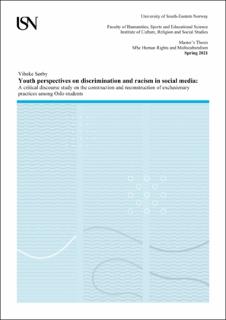| dc.contributor.advisor | Mezzanotti, Gabriela | |
| dc.contributor.author | Sørby, Vibeke | |
| dc.date.accessioned | 2021-09-22T16:12:31Z | |
| dc.date.available | 2021-09-22T16:12:31Z | |
| dc.date.issued | 2021 | |
| dc.identifier | no.usn:wiseflow:2623102:43269139 | |
| dc.identifier.uri | https://hdl.handle.net/11250/2780571 | |
| dc.description.abstract | This research provides a critical analysis of racist and discriminatory discourse in Norwegian media. Findings show how contemporary structures in Norway is casual factor when explaining racial phenomenon in the society. Mechanisms, practices, and social relations examined in this paper, creates the casual factors for the production and reproduction of racial inequality at all levels (Bonilla-Silva, 1997, s. 476). Media plays a special role in this process. As elite actors, the media is particularly influential in reproduction of racism (Dijk T. V., 1993, s. 24). Presented findings exemplifies how Norwegian elites applies denial strategies and disclaimers as a part of their reproduction of white hegemonic power over those considered as ‘other’ (OHRC, 2004). At the same time, such mechanisms is a part of strengthening the majorities sense of national belonging. The presence of systematic denials of the existence of racism, and the reluctance to describe it as such, is a part of the contemporary concept of racism (Bangstad, 2017). Acknowledging the presence of racism in the society would question and shake the understanding of Norwegian society as a dominant democratic and humanitarian great power.
This research shows how different discourses is Norwegian social media contributes to the production and reproduction of discrimination of minorities. Identified discourses of colorblind racism, boundary construction and blaming the victim contributes to denials, minimalizations and naturalization of racism as a social and political phenomenon. The black face debate presented, exemplifies how white elites equate their experience with black experience and illustrate contemporary colorblind racism, “a discourse in which it is not permissible to raise the issue of race” (Doane, 2003, p. 13). Contemporary usage of the word ‘negro’ in the Norwegian society, exemplifies the present ‘perception gap’ between blacks and whites, and the existing white racial unconsciousness. Further this thesis finds that racist humor is a central component in reinforcing every day and systematic forms of white supremacy (Pérez, 2017, p.957). Findings presented in this thesis illustrate the harm racialized discourse creates, and the context youths develop their understanding of life and society. | |
| dc.description.abstract | This research provides a critical analysis of racist and discriminatory discourse in Norwegian media. Findings show how contemporary structures in Norway is casual factor when explaining racial phenomenon in the society. Mechanisms, practices, and social relations examined in this paper, creates the casual factors for the production and reproduction of racial inequality at all levels (Bonilla-Silva, 1997, s. 476). Media plays a special role in this process. As elite actors, the media is particularly influential in reproduction of racism (Dijk T. V., 1993, s. 24). Presented findings exemplifies how Norwegian elites applies denial strategies and disclaimers as a part of their reproduction of white hegemonic power over those considered as ‘other’ (OHRC, 2004). At the same time, such mechanisms is a part of strengthening the majorities sense of national belonging. The presence of systematic denials of the existence of racism, and the reluctance to describe it as such, is a part of the contemporary concept of racism (Bangstad, 2017). Acknowledging the presence of racism in the society would question and shake the understanding of Norwegian society as a dominant democratic and humanitarian great power.
This research shows how different discourses is Norwegian social media contributes to the production and reproduction of discrimination of minorities. Identified discourses of colorblind racism, boundary construction and blaming the victim contributes to denials, minimalizations and naturalization of racism as a social and political phenomenon. The black face debate presented, exemplifies how white elites equate their experience with black experience and illustrate contemporary colorblind racism, “a discourse in which it is not permissible to raise the issue of race” (Doane, 2003, p. 13). Contemporary usage of the word ‘negro’ in the Norwegian society, exemplifies the present ‘perception gap’ between blacks and whites, and the existing white racial unconsciousness. Further this thesis finds that racist humor is a central component in reinforcing every day and systematic forms of white supremacy (Pérez, 2017, p.957). Findings presented in this thesis illustrate the harm racialized discourse creates, and the context youths develop their understanding of life and society. | |
| dc.language | eng | |
| dc.publisher | University of South-Eastern Norway | |
| dc.title | Youth perspectives on discrimination and racism in social media | |
| dc.type | Master thesis | |
